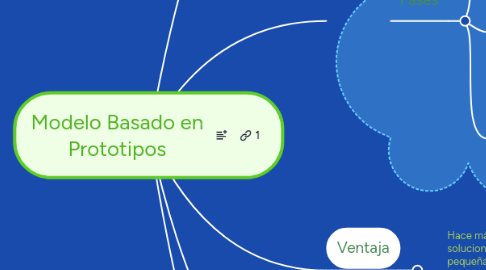
1. Fases
1.1. Fase 1: Entrevistar a los usuarios para entender lo que necesitan
1.2. Fase 2. Construir un prototipo de forma rápida basado en lo que los usuarios necesitan
1.3. Fase 3. Los usuarios experimentan con el prototipo y estos proveen la retroalimentación sobre lo que a ellos les gustó y no les gustó acerca del prototipo proporcionado.
2. Ventaja
2.1. Hace más rápido el diseño de soluciones de software pequeñas
2.1.1. Situational Analysis / Drivers
2.1.1.1. What is driving us to do this?
2.1.1.2. SWOT Analysis
2.1.1.2.1. Strengths
2.1.1.2.2. Weaknesses
2.1.1.2.3. Opportunities
2.1.1.2.4. Threats
2.1.1.3. Customer Findings - What have we learned from customers?
2.1.2. Competitive Analysis
2.1.2.1. Do we have competitors and threats in these target markets with the proposed offerings?
2.1.2.2. What are our competitors doing and how are they positioning?
2.1.2.3. How do we position against each competitor?
2.1.3. Target Customer(s)
2.1.3.1. Buyer Profile
2.1.3.1.1. Title
2.1.3.1.2. Industry
2.1.3.1.3. Geography
2.1.3.1.4. Business Size
2.1.3.2. Influencer Profile
2.1.3.3. User Profile
2.1.3.4. What do customers want and need?
2.1.3.5. What business problems do each of these customers have?
2.1.4. Customer Segmentation
2.1.4.1. Which customers or sets of customers do we sell to?
2.1.4.2. What are the target market segments that we want to go after?
2.1.4.3. What are the distinct problems for each segment of the market?
2.1.5. Total Available Market
2.1.5.1. New Prospects
2.1.5.1.1. How much of each target segment have we penetrated?
2.1.5.1.2. How much opportunity is available in each target segment?
2.1.5.2. Existing Customers
2.1.5.2.1. Can we up-sell existing customers?
3. Consiste en la creación de una implantación parcial de un sistema con la finalidad de comprender los requerimientos del usuario final.
3.1. Purpose
3.2. Stakeholders
3.3. Project Team
3.4. Related Documents
3.5. Author(s)
3.6. Sign-Off List
3.6.1. Training
3.6.2. Channels
3.6.3. International
3.6.4. Public Sector
3.6.5. Sales
3.6.6. Marketing Communications
3.6.7. Product Management
